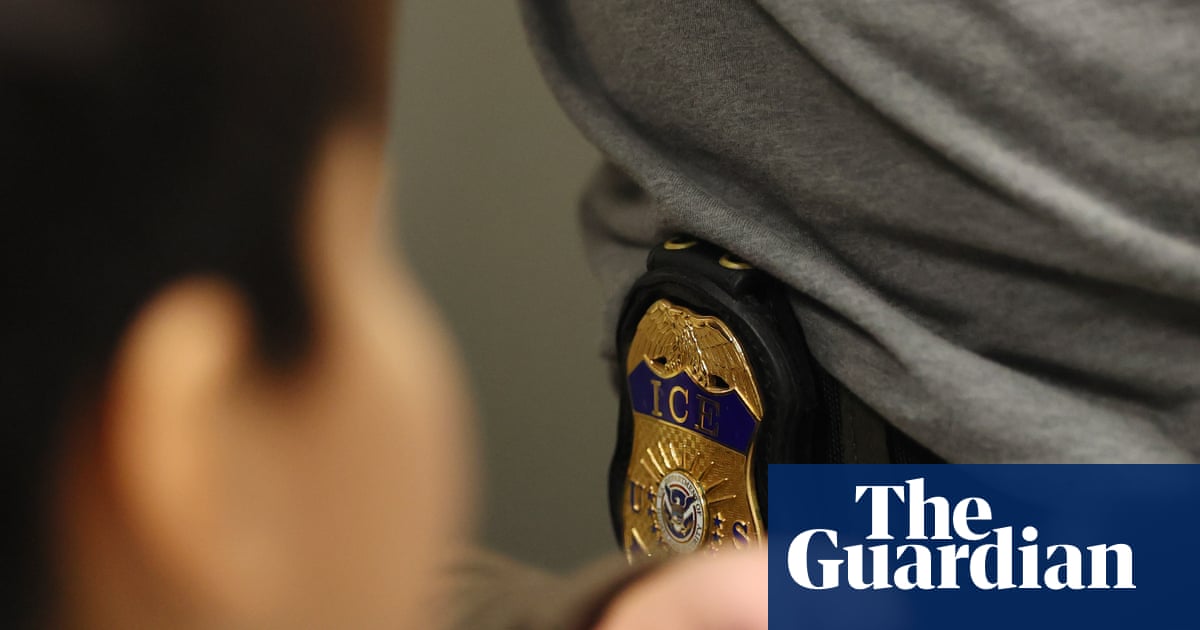Crowley Place is a sleepy street in the Waynewood area of south Alexandria, Virginia, a suburb 30 minutes from DC. The unassuming homes are well-tended, and it’s a quick walk to six different churches.
But each year at Halloween the police shut down the street as thousands of visitors flock to the area. It’s all due to two ageing brothers who spent 40 years working together in secret at a laboratory in the CIA.
For six weeks, no matter what was going on in the world, the Park brothers would take leave from the agency – using vacation, sick days, and anything else they could think of— and construct an elaborate front-yard Halloween display, often using CIA-inspired technology.

The espionage careers of Jeff and Brian Park spanned the cold war, the Russian occupation of Afghanistan, Ronald Reagan’s war to topple the Sandinistas in Nicaragua, the collapse of the Soviet Union, the Gulf war, and the global “war on terror”.
Among the true insiders in the intelligence community, they were something of a legend. Among their specialties in the CIA office of technical services was to help to sabotage Russian systems. It is an obscure discipline even for intelligence services – sabotaging weapons can mean anything from secretly ruining rifle ammunition to hacking the guidance systems for an anti-aircraft missile.
Still, their CIA work was just one part of their lives. Their obsession and delight was Halloween.
It was three years ago that I first heard of the duo. My sources, veterans of the CIA, just called them the “Park brothers” – and spelled out their unusual expertise, claiming they didn’t remember their first names. It was difficult to track them down because Park was such a common name, but this year I used public records databases, keying in what their ages must be, and scanning through hundreds of names to find adjacent homes, and finally got their address.
Outside the two adjacent homes on Crowley last week – the brothers own both– there was an absolute mess of black tents and graveyards, dotted with skeletons, robots, pirates and gory monsters. Lines overhead guide the flying witch and giant spider.
Once I showed up on their lawn, the Park brothers were happy to talk.
Jeff Park, 78, was pondering a jumble of electronics underneath a witch and near some skulls. He wore a brown T-shirt tucked neatly into tactical grey pants.

“It takes six weeks to put this together and six weeks to take it apart,” he told me. He said he and his brother Brian, who strolled by lugging some equipment in a handcart, had started their display in 1977, and have been enlarging it ever since.
“When I retired in ‘14 I was the senior scientist at the CIA,” Jeff said, “so we got to do a lot of cool things. Things that you would go to jail for anywhere else.”
Jeff confirmed what sources had said – that they used to sabotage Russian missiles. “We basically specialized in doing in – my brother and I, in our careers – doing in weapon systems. Not just that, lots of other things too. But that was what we did. We did a lot of sabotage on weapon systems to stop the bad guys from doing stuff that we didn’t want them to do.”
Brian Park, 75, has longer hair and a big smile. He said getting hired at the office of technical services in the 1970s was “like marrying into an extended Italian family”. Jeff added: “A mafiosa family.”
But before talking about the CIA, they wanted to discuss Halloween. Jeff speaks fast, like an enthusiastic professor or Doc Brown of Back to the Future. He pointed out where the displays were going. “There will be Igor, there,” he pointed, “and the Gremlin and Ninja Turtle and ET and Yoda goes over there.” All of them, he says, are animatronic.
The hi-tech displays are everywhere – all made by the Parks out of raw materials or discarded electronic devices, rescued parts, or remnants of some CIA experiments. There are elaborate cameras with radar and sonar sensors and a home engineered twelve-channel digital surround sound system threaded through the yard. There’s a giant cauldron – inspired by Disney’s Fantasia – with a computer and a smoke machine inside that emits different colors of smoke. Put your face too close and there’s a sensor to launch a surprise.
A couple of graveyards, and one tombstone that flickers with a name changed at will.
Jeff collects gargoyle statues; he’s got 210 of them so far. The gargoyles aren’t really part of the Halloween display, however, so they are just piled in the backyard for the winter.
The living rooms of one Park home has what appears to be an old and worn-down La-Z-Boy chair, and the faded wall-to-wall carpet is littered with robots they built for bomb-disposal operations many years ago. On the walls are Christmas ornaments the Parks’ mother used to make.
One house has all the electrical engineering supplies, with walls crammed with industrial shelving for resistors and capacitors and electrical connectors. There’s a massive specialized machine for making circuit boards.
The other house has a metalworking shop, where the lathe is still littered with brass shavings.

Jeff has been setting up the animatronic gremlin they built. “We wrote software to modify his personality,” Jeff said, “as a function of your body movement. So you have a series of doppler shift radars that measure your body motion and it modifies how he reacts. So if you’re very calm and collected, he will look at you, OK? And then if you get hyper, then he pays no attention to you whatsoever.”
Jeff said the exhibit is the most interactive. “Little kids, even four-year-old kids, know there is something special about him. Like, one year we had to cut his head open to repair something and they cried because they thought we were hurting him.”
Close by is the alien rocket ship, with blue windows through which the alien is visible. It’s abandoned radio frequency testing equipment. “The throttle is from a B1 bomber prototype,” Jeff said, pointing inside. It emits huge clouds of smoke for Halloween.
In one back shed is a virtual reality device they first engineered in the 1970s for the CIA. Now it’s used to control a handmade, four-legged Star Wars Imperial Walker about five feet tall. “It’s got a 3,000-watt second strobe,” Jeff said. “You can feel it on the back of your neck at 20 feet.”
The Parks joined the CIA in 1973. Brian Park was first, part of a fellowship program, and he convinced his bosses to meet with Jeff. Jeff insisted his first CIA interview – just to informally screen him – was at a downtown DC strip club that’s gone out of business.
Brian said one early assignment was designing a specialized camera for a now well-known Russian spy for the CIA. “We had to build him a super tiny camera that would digitally store all this stuff so he wouldn’t have to put himself at risk. And so the first technology we used in the camera, the only way you could store digital, non-mechanically, was magnetic bubble memory.”
It was the early days of digital memory. “We did something audacious. We shoveled four chips into one coil set and spent millions of dollars.”
Whatever they did couldn’t protect the spy, whom the Russians executed in 1985. The story is the subject of a 2015 book and an upcoming movie starring Russell Crowe. And the technology they used – “bubble memory” – soon vanished from memory, obsolete.
The CIA stories are never far away. Brian was lugging some Halloween display parts in a cleverly made cart, a one-handed wheelbarrow fashioned to distribute weight laterally.
Jeff claimed the cart’s deck, fashioned out of a honeycombed aluminum material, used to reinforce the deck of racing boats he said were sent to the Contras, rigged with machine guns with massive recoil. He pointed at the cart. “That’s what’s left over!”
Speedboats were indeed deployed to the region and provided to US proxies. Some speedboats were used in 1984 in CIA sponsored Contra efforts to mine Nicaraguan harbors, an operation the international court of justice at The Hague declared illegal. It’s unclear if the specific boats the Park brothers refitted were used for that operation.
Most of the year Brian and Jeff also have a railroad track made of aircraft-grade aluminum that encircles their property, over hills and bridges. It is for a miniature working steam engine that they handcrafted, with a seat so kids can ride it. Jeff said they built it using aircraft grade aluminum. Unprompted, that launched him on a story about working on the track helped him as he engineered an early drone program in 1990, targeting Iraq.

He said the agency developed and deployed 25 of the unmanned aerial systems, with seven foot wingspans, prop driven gas engines – for reconnaissance, distributing propaganda leaflets, and finally for kamikaze bombing runs – and he boasted that earned him a promotion to the senior intelligence service level.
It’s unusual to find people willing to chat about intelligence technology, even outdated gear. The CIA declined to comment on the Park brothers’ revelations.
One of the things they’re proud of – “the coolest thing we ever did” – was an ambitious plan to destroy scud missiles deployed by Russian client states.
Earlier sources had referenced this when explaining the genius of the Park brothers, so hearing the details directly from them was like watching a movie where I’d only seen the trailer.

By engineering one key part, the brothers believed that deployed scud missiles would make a U-turn and hit their own launching sites.
“At the time the Soviet Union had come apart and so they were selling off to the black market a lot of the components that are used in Russian missiles,” Jeff said. “And so we basically went out, bought a bunch of them, brought them back to our contractors, modified them with my circuit.”
In the end, the operation never moved forward. He said it was canceled because of resistance from the state department, worried about blowblack.
Jeff boasted of another invention that he says he designed for US special operations. “It was the thing that probably put my name on the map. I had this crazy, wild-ass idea about how to build an infra-red beacon that you could see 10 miles away with night-vision glasses, and if you were two inches away from it you couldn’t see anything, using light-emitting diodes.”
To convince the Navy Seals it worked, the brothers said, they invited the special operations forces to the halloween festivities, and hid a beacon in a hedge a couple streets over.
After that, “for five years, I personally made all the night-vision beacons for the entire US military, including the Seals, Delta Forces, the Rangers. And that made me world famous.”

Jeff described one of their final plots – sabotaging Russian-made batteries, intercepted by the CIA, that Iran planned to install as an underground power back-up system for a nuclear facility.
On this mission, the way he describes it, they went somewhat rogue. “Since it was two days after Christmas, all the bosses were on leave. And so there was just us in there. And so a whole bunch of us got together and we said, ‘Let’s screw the bad guys.’ So I trained a group of 10 people to drill holes randomly in the batteries, the diameter of a sewing machine needle.”
The undetectable holes would slowly leak out the hydrogen and oxygen, to raise the internal resistance, and heat, of the battery to an explosive level.
The brothers retired before they ever found out if the plan worked.

Certainly their CIA, the one they talk about, is an agency where the notorious baggage and failures and scandal don’t play a leading role.
This version of the CIA is not necessarily troubled by the old enhanced interrogation program, the “salt pit” death in Afghanistan, or “renditions”, or involvement in the mistaken shooting down of a plane carrying an American missionary family.
Jeff said about two-thirds of all he did at the CIA never came to fruition, rejected by higher-ups or unsuccessful.
But the Park brothers’ massive Halloween spectacle is at least a successful mission for them – where kids can be tricked and still be happy, where covert technology and deception actually work.


 German (DE)
German (DE)  English (US)
English (US)  Spanish (ES)
Spanish (ES)  French (FR)
French (FR)  Hindi (IN)
Hindi (IN)  Italian (IT)
Italian (IT)  Russian (RU)
Russian (RU)  3 weeks ago
3 weeks ago























Comments